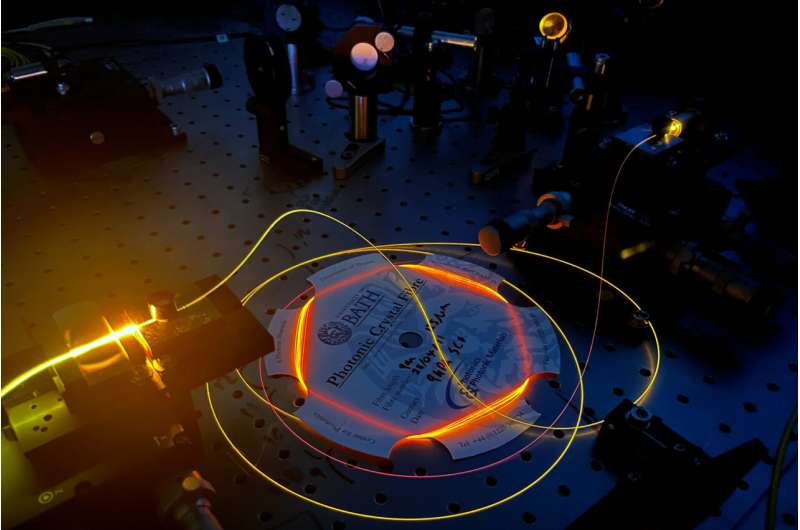This article has been reviewed according to Science X's editorial process and policies. Editors have highlighted the following attributes while ensuring the content's credibility:
fact-checked
trusted source
proofread
Optical fibers fit for the age of quantum computing

A new generation of specialty optical fibers has been developed by physicists at the University of Bath in the UK to cope with the challenges of data transfer expected to arise in the future age of quantum computing.
Quantum technologies promise to provide unparalleled computational power, allowing us to solve complex logical problems, develop new medicines and provide unbreakable cryptographic techniques for secure communications. However, the cable networks used today to transmit information across the globe are likely to be sub-optimal for quantum communications, due to the solid cores of their optical fibers.
Unlike regular optical fibers, the speciality fibers fabricated at Bath have a micro-structured core, consisting of a complex pattern of air pockets running along the entire length of the fiber.
"The conventional optical fibers that are the workhorse of our telecommunications networks of today transmit light at wavelengths that are entirely governed by the losses of silica glass. However, these wavelengths are not compatible with the operational wavelengths of the single-photon sources, qubits, and active optical components, that are required for light-based quantum technologies," said Dr. Kristina Rusimova from the Department of Physics at Bath.
Dr. Rusimova and her colleagues describe the state-of-the-art fibers made at Bath, along with other recent and future developments in the emerging field of quantum computing, in an academic paper published in Applied Physics Letters Quantum.
Dr. Rusimova, who is lead senior author of the paper added, "Optical-fiber design and fabrication is at the forefront of the University of Bath Department of Physics research, and the optical fibers we are developing with quantum computers in mind are laying the foundations for the data transmission needs of tomorrow."
Quantum entanglement
Light is a promising medium for quantum computation. The individual particles of light, called photons, possess some uniquely quantum properties that can be harnessed by quantum technologies.
One such example is quantum entanglement, where two photons separated by a large distance not only hold information about one another but can also instantly influence each other's properties. Unlike the binary bits of classical computers (either a one or a zero), pairs of entangled photons can in fact exist as both a one and a zero at the same time, unleashing enormous amounts of computational power.
Dr. Cameron McGarry, until recently a physicist at Bath and first-author of the paper, said, "A quantum internet is an essential ingredient in delivering on the vast promises of such emerging quantum technology.
"Much like the existing internet, a quantum internet will rely on optical fibers to deliver information from node to node. These optical fibers are likely to be very different to those that are used currently and will require different supporting technology to be useful."
In their perspective, the researchers discuss the associated challenges of the quantum internet from the viewpoint of optical fiber technology and present an array of potential solutions for scalability of a robust, wide-scale quantum network.
This encompasses both the fibers that will be used for long-range communication, and specialty fibers that will allow for quantum repeaters, integrated directly into the network in order to extend the distance over which this technology can operate.
Beyond connecting nodes
They also describe how specialty optical fibers can go beyond connecting nodes of a network to implementing quantum computation at the nodes themselves by acting as sources of entangled single photons, quantum wavelength converters, low-loss switches, or vessels for quantum memories.
Dr. McGarry said, "Unlike the optical fibers that are standardly used for telecommunications, speciality fibers which are routinely fabricated at Bath have a micro-structured core, consisting of a complex pattern of air pockets running along the entire length of the fiber.
"The pattern of these air pockets is what allows researchers to manipulate the properties of the light inside the fiber and create entangled pairs of photons, change the color of photons, or even trap individual atoms inside the fibers."
"Researchers around the world are making rapid and exciting advancements in the capabilities of microstructured optical fibers in ways that are of interest to industry," said Dr. Kerrianne Harrington who is a postdoctoral researcher in the Department of Physics.
"Our perspective describes the exciting advances of these novel fibers and how they could be beneficial to future quantum technologies."
Dr. Alex Davis, an EPSRC Quantum Career Acceleration Fellow at Bath, added, "It's the ability of fibers to tightly confine light and transport it over long distances that makes them useful.
"As well as generating entangled photons, this allows us to generate more exotic quantum states of light with applications in quantum computing, precision sensing and impregnable message encryption."
Quantum advantage – the ability of a quantum device to perform a task more efficiently than a conventional computer – has yet to be conclusively demonstrated. The technological challenges identified in the perspective are likely to open new avenues of quantum research, and bring us closer to achieving this important milestone. The optical fibers fabricated at Bath are expected to help lay the foundations for the quantum computers of tomorrow.
The team of researchers at Bath also included senior lecturer, Dr. Peter Mosely.
More information: Cameron McGarry et al, Microstructured optical fibers for quantum applications: Perspective, APL Quantum (2024). DOI: 10.1063/5.0211055
Provided by University of Bath





















